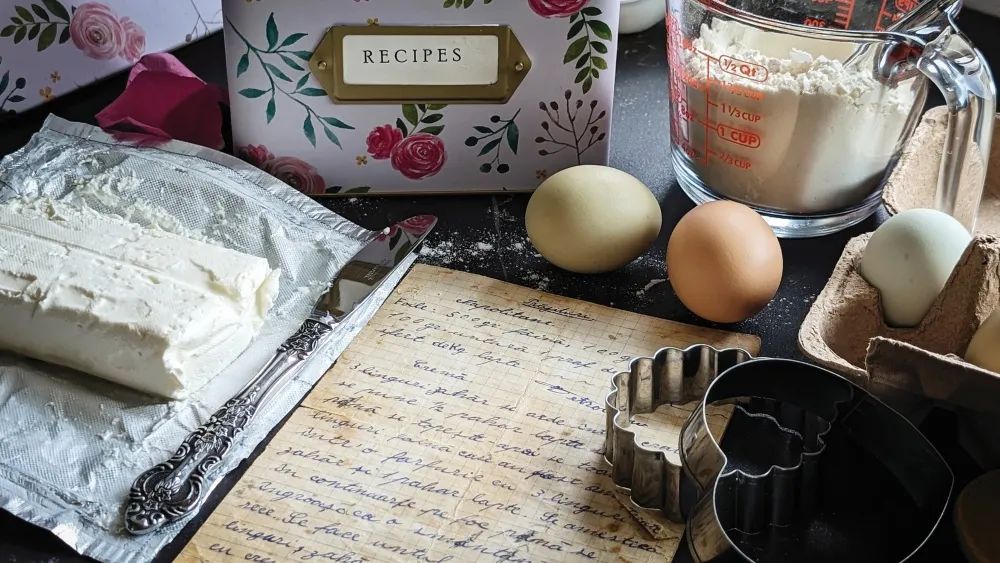
The Timeless Charm of Handwritten Recipes
May 2024
by renata haidle
In an era dominated by the pixelated whispers of AI and the fleeting trends of online platforms, beautifully styled Pinterest boards, and handy how-to YouTube videos, the quaint charm of handwritten recipe cards might seem antiquated. After all, who needs faded ink and dog-eared corners when a perfectly formatted, SEO-optimized recipe is just a click away? Yet, within these unassuming cards lies a forgotten world, a tapestry woven with sentimentality, poetry, and the essence of human connection, making them treasures worth preserving beyond the allure of digital convenience.
A Window into The Past
The romantic value of recipe cards lies in their tangible nature. Unlike the fleeting existence of online recipes, they possess a physical presence, a weight that grounds them in reality. Each stain of tomato sauce is reminiscent of laughter-filled kitchens, and each smudge of flour tells a story of culinary triumphs and mishaps. Recipe cards are imbued with the energy of their creators, becoming extensions of their personalities and histories. Holding a cherished recipe card is like holding a piece of someone you love, a connection that transcends time and technology.
Exploring The Culinary Vernacular
Beyond the recipes, the language used on these handwritten cards offers a glimpse into a kitchen lexicon gradually fading into obscurity. Terms like oleo, scald, or whip the tar out of it were once commonplace in kitchen conversations but are now often replaced by more modern equivalents or omitted altogether in digital recipes. Yet, these archaic words carry a sense of tradition and craftsmanship, harkening back to when recipe writing was as much about technique as it was about telling a story.
Passing Down More Than Recipes
Handwritten recipe cards are more than just culinary instructions; they are repositories of family lore and cherished memories. Passing down a recipe from one generation to the next is imbued with a sense of continuity and connection, linking past, present, and future in a deliciously tangible way. As we hand over these precious keepsakes to our children and grandchildren, we are not only imparting culinary knowledge but also sharing a piece of ourselves—our traditions, our values, and our love.
Honoring The Artisans of The Kitchen
Behind every handwritten recipe card lies a culinary artisan – a grandmother, a mother or father, an aunt – whose skill and expertise have been honed through years of practice and experimentation. They may not have had fancy culinary degrees or Instagram-worthy plating skills, but their mastery of the spoon and spatula was evident in every dish they lovingly prepared. By preserving their recipes and passing them down to future generations, we pay homage to those who came before us and ensure their legacy lives on.
A Sense of Poetry
But the magic extends beyond the tangible. Handwritten recipe cards are often infused with a certain poetry. Ingredients are not just listed; they are described with flourishes of personal preference. Measurements are not sterile digits but suggestions, whispers of "a generous pinch," “a dash,” or "enough to make the batter hug your spoon." These annotations are more than just instructions; they are love notes to the dish, imbued with the warmth of generations past.
Furthermore, these cards are repositories of collective memory. They serve as vessels for passing down not just culinary knowledge but also cultural heritage, family traditions, and the unspoken language of love shared through food. Grandmothers' spidery handwriting evokes memories of childhood kitchens, while faded ink tells stories of long-gone celebrations. In a world where traditions are often lost to the digital abyss, recipe cards act as anchors, tethering us to our roots and reminding us of where we come from.
Not Dissing the Digital
This isn't to say that digital recipes are devoid of value. They offer accessibility, ease of modification, and a vast array of culinary inspiration. However, their very nature lends them to a transient existence. They are easily lost, forgotten, or replaced by the next trending blog or social media app. In contrast, recipe cards endure. They become cherished heirlooms, passed down through generations, each stain and splatter adding to their atemporal charm.
The act of using a handwritten recipe card is itself an act of ritual. It's a slow dance with the past, feeling the weight of history in your hands. It's a deliberate rejection of the instant gratification offered by online platforms, a conscious choice to savor the journey as much as the destination. In the quiet moments spent deciphering grandma's scrawl, the connection deepens, the memory strengthens, and the food becomes more than just sustenance – a bridge to the ones we loved and lost.
In a world increasingly dominated by the digital, the handwritten recipe card is a testament to human connection's enduring power. It is a reminder that the most cherished things in life cannot be downloaded or streamed. They are passed down, shared, and savored, their value measured not in bytes, but in the warmth of memories and the love woven into every bite. So, the next time you reach for a treasured recipe card, remember: you are not just holding a recipe. You are holding a piece of your history, a connection to your loved ones, and a testament to the enduring power of food to nourish the body and the soul.
Originally printed in the May 2024 issue of Simply Local Magazine
Never miss an issue, check out SLM's digital editions here!





